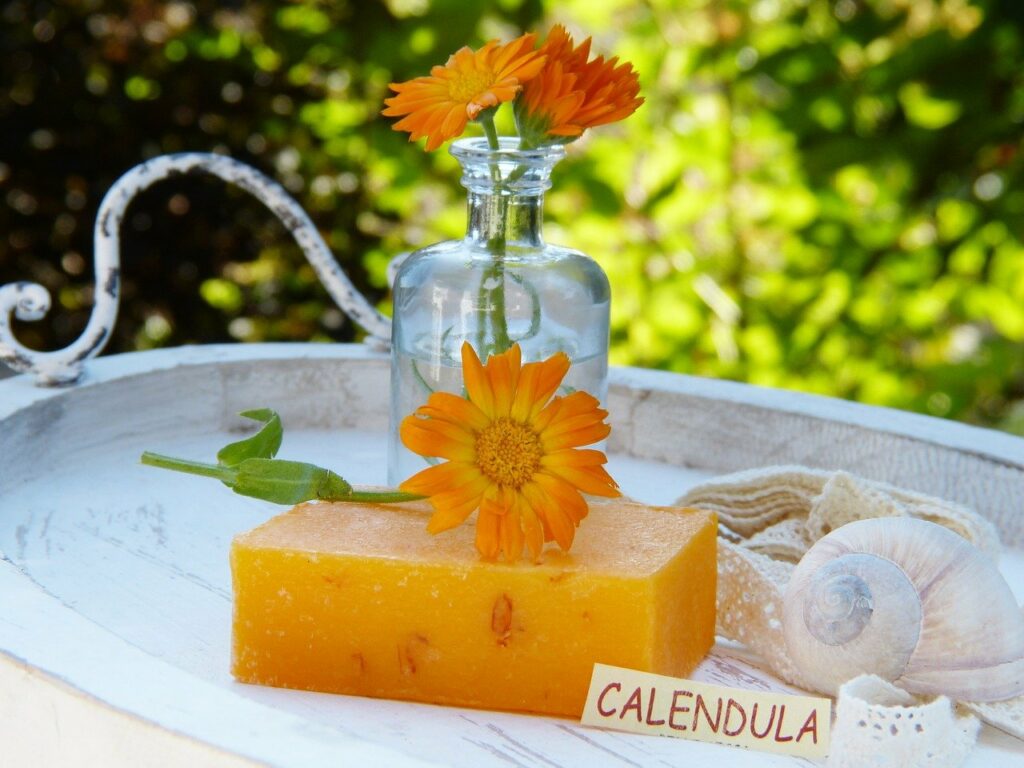
Calendula is a plant that has been used for centuries for its medicinal and culinary properties. From its bright orange and yellow petals to its delicate aroma, Calendula is a plant that captures the heart and soul of anyone who encounters it. In this article, we will explore the history, benefits, and uses of Calendula, from its use in skincare products to its potential as a natural remedy for various health conditions. So, whether you’re a gardening enthusiast, a natural health advocate, or simply curious about this vibrant plant, keep reading to discover the wonders of Calendula.
Overview of Calendula
Calendula (Calendula officinalis) is an annual flowering plant in the daisy family. It is native to the Mediterranean but has become naturalized in many other areas of the world. Many gardeners grow it for its color and ease of care. The plant has yellow or orange flowers, and the flower petals are edible.
It has a long history of use in herbal medicine and is believed to have anti-inflammatory, antiseptic, and wound-healing properties. It has been used for centuries to treat skin conditions such as eczema, psoriasis, and rashes. It is also used to treat cuts, scrapes, and minor wounds, as well as bruises, swelling, and insect bites.
The petals can be made into a tea or tincture to aid digestion and reduce inflammation. Calendula can be applied directly to the skin as an ointment or cream, or taken in capsule form.
The plant is widely used in herbal medicine and is considered to be safe for most people when taken as directed. However, as with any herbal remedy, it is best to consult a qualified healthcare provider before using it.
Historical Uses of Calendula
Calendula has been used in traditional medicine for centuries to treat a variety of ailments, including skin infections and inflammation, wounds, digestive issues, and menstrual cramps.
In the Middle Ages, it was used to treat many ailments, including headaches, skin infections, and fever. During this time, it was also used to reduce inflammation and to help speed the healing of wounds. In the 16th century, it was used in England to treat dysentery, a severe intestinal disorder.
In modern times, calendula is still used for its healing properties. It is commonly used topically to treat various skin conditions, including acne, psoriasis, and eczema. It can also be used to soothe cuts and burns and reduce inflammation. Constituents contained within the flowers have been found to have antiseptic, antifungal, and antiviral properties. It can also be taken internally to treat digestive issues and menstrual cramps.
Today it is widely available in many forms, including dried flowers, tinctures, ointments, and teas. It is considered a safe and effective medicinal herb with few side effects.

Benefits of Calendula
Skin Care
Calendula, also known as pot marigold, has been used for centuries to treat skin ailments topically. The plant contains active compounds such as flavonoids, triterpenoids, and carotenoids that have anti-inflammatory, antioxidant, and antibacterial properties. In addition, it has antiseptic and wound-healing properties.
It can be used to treat a variety of skin conditions, such as:
• Cuts, scrapes, and minor wounds: It can help to speed up the healing process of these minor wounds, as well as reduce pain and inflammation.
• Acne: Applying a calendula-infused oil to the skin can help to reduce the appearance of acne.
• Eczema: It is often added as an ingredient in topical creams and ointments to reduce the inflammation, itching, and redness associated with eczema.
• Sunburns: Applying calendula-infused oil to sunburns can help to reduce the pain and speed up the healing process.
• Aging skin: Applying a calendula-infused oil to the skin can help to reduce wrinkles and fine lines, as well as improve skin elasticity.
It can be used in a variety of ways for skin care. It can be made into tea, infused into oils, or used as an ingredient in topical creams and ointments. When using any product containing calendula, it is important to do a patch test first to ensure that you do not have an allergic reaction.
Wound Healing
The calendula plant has long been used as a natural remedy for wound healing. It has anti-inflammatory, antibacterial, antiviral, and antifungal properties that make it effective in treating wounds. It has been used to reduce inflammation, improve circulation, and promote healing.
It can be used topically as a compress or a salve or taken internally as an infusion. Applied topically, it can be used to reduce inflammation and speed up the healing process in wounds. It can be applied directly to the wound as a compress or a salve, or it can be applied to bandages and dressings.
It can also be used to reduce the size of open wounds by promoting the growth of healthy tissue. By helping to increase blood flow to the area it promotes the formation of new tissue.
It can also be taken internally as an infusion to boost the body’s natural healing abilities and reduce inflammation. You can brew a tea to help treat digestive issues such as constipation, cramps, and indigestion.
Overall, calendula is a safe and effective way to promote wound healing. It is a natural and gentle remedy that can be used to reduce inflammation and promote healing.
Immune System Support
Calendula has been found to be effective in boosting the body’s natural immunity and helping to fight off invading pathogens.
It contains numerous compounds that have been shown to support the body’s immune system. These compounds work together to stimulate and strengthen the body’s natural defenses against viruses and bacteria. It contains flavonoids, which are antioxidants that can help protect cells from damage caused by free radicals. Additionally, the plant contains carotenoids, which have anti-inflammatory effects and can reduce the risk of certain cancers.
Calendula also contains several compounds that can stimulate the production of white blood cells and antibodies. The plant is known to increase the production of interferon, which is a cytokine that helps to regulate the body’s immune response. Additionally, it can help to reduce the production of pro-inflammatory cytokines, which are known to be involved in the development of autoimmune diseases.
Studies have found that it can be used to help the body fight off viral and bacterial infections. Brewed and taken as a tea, it can also help to reduce the severity of colds and flu.
It is generally safe for use and does not typically cause any side effects. However, it is important to discuss any potential risks with a healthcare provider before taking calendula.

How to Use Calendula
Topical Application
Calendula is a great choice for treating minor cuts, scrapes, and burns. It can even help soothe insect bites and reduce the itching and swelling associated with them.
Calendula can also help to reduce dryness and irritation of the skin, making it a great choice for those with eczema, psoriasis, and other skin conditions. It can help to reduce redness, swelling, and inflammation. It is also known to have a calming effect on the skin and is often used to treat diaper rash and other skin irritations in babies.
Some products that list calendula as an ingredient include creams, lotions, balms, salves, and ointments. Some common brand names include Boiron Calendula Cream, Weleda Calendula Ointment, and Nature’s Herbal Calendula Salve. Similar products can be found in most health food stores and natural products stores.
Tincture
Calendula’s therapeutic properties make it a popular choice for creating a tincture.
The Benefits of Making a Calendula Tincture
Creating a tincture with calendula offers a variety of benefits. It is rich in flavonoids, which are known to have anti-inflammatory and antioxidant properties. It is also known to have antiseptic and anti-fungal properties, which can help to treat a range of skin conditions, from minor cuts and scrapes to more serious infections.
It is known to promote wound healing and can be used to treat burns, bruises, and even insect bites. It can also be used to treat gastrointestinal issues, such as indigestion and stomach cramps. Finally, calendula is known to be effective in reducing fevers and relieving sore throats.
Making a Calendula Tincture
Making a calendula tincture is a fairly simple process. You will need:
• Dried calendula flowers
• A clean glass jar
• 80-proof vodka
• Cheesecloth
• A glass dropper bottle
Instructions:
- Start by filling the glass jar halfway with the dried calendula flowers.
- Fill the jar the rest of the way with the vodka, making sure to cover the flowers completely.
- Cover the jar with the cheesecloth and secure it with a rubber band.
- Place the jar in a cool, dark place, and let it sit for at least 4 weeks, and up to 8 weeks
- After 4-8 weeks, strain the tincture through the cheesecloth into a glass dropper bottle.
- Store the tincture in a dark, cool place and use it as needed.
Making a tincture is a great way to take advantage of the medicinal properties of this beneficial plant. With its anti-inflammatory and antiseptic properties, it can help to treat a variety of conditions and promote overall health and well-being.
Tea
Calendula tea is one of the most well-known herbal teas for its medicinal properties. The tea is known to have anti-inflammatory, antispasmodic, and anti-bacterial properties. It can be used for healing wounds, soothing sore throats, and relieving skin irritations.
Making calendula tea is a simple process. The first step is to gather the calendula flowers. The petals should be plucked from the flower head and laid out on a clean surface to dry. Once the petals are dry, they can be stored in an airtight container. Or you can buy them online in ready-to-use tea bags.
To make the tea, place two teaspoons of dried calendula petals in a teapot and add one cup of boiling water. Steep the mixture for 10 minutes and strain the liquid into a cup. The tea should be enjoyed while it is still warm.
Calendula tea is a great way to take advantage of the healing properties of this amazing healing flower. Not only can it help to soothe sore throats and skin irritations, but it also has anti-inflammatory and antispasmodic properties. Making this tea is a simple process, and the tea can be enjoyed warm or cold.
Safety Considerations
It is important to understand that calendula has the potential to cause adverse reactions and should be used with caution.
When considering the use of calendula, keep in mind that it can act as a photosensitizer, meaning that it can make the skin more sensitive to the sun. Therefore, it is important to limit sun exposure while using calendula and to wear protective clothing and sunscreen when outdoors.
It may also interact with certain medications, so it is important to speak to a healthcare professional before combining it with any medication. Additionally, calendula has been known to cause allergic reactions in some people, so it is important to do a patch test before using it.
Finally, calendula is not recommended for pregnant women, as it can stimulate the uterus and lead to premature labor. It is important to be aware of the potential risks associated with its use and to consult with a healthcare professional before using it.
Possible Side Effects
Common side effects of calendula include nausea, vomiting, and diarrhea. In rare cases, calendula can cause allergic reactions such as hives, itching, and swelling of the skin or lips. If you experience any of these side effects, you should stop taking the calendula and seek medical attention.
Additionally, it can interact with certain medications, such as anticoagulants, statins, and some antibiotics, so it is important to speak to your healthcare provider before using it. It is generally considered safe when taken by mouth, as long as it is taken in the recommended dosage.
It is important to note that calendula has not been studied extensively in pregnant or breastfeeding women, so it is best to avoid its use in these cases.
Since it can have potential side effects and is known to interact with certain medications, it is important to speak to a healthcare provider before taking calendula as an herbal remedy, especially if you are pregnant or breastfeeding.
Drug Interactions
It is important to note that calendula may interact with certain medications, so it is important to be aware of the potential interactions before using it.
When using calendula, it is important to avoid taking it with certain medications such as blood thinners, sedatives, diuretics, and medications used to treat diabetes. Calendula may also interact with other herbs and supplements, such as garlic, ginkgo, and ginseng. Additionally, it may interact with some chemotherapy drugs, so it is important to speak with your doctor before taking it if you are undergoing chemotherapy.
Edible Parts
Calendula is an edible flower that has a wide range of uses in cooking, medicine, and even cosmetics. The petals have a slightly bitter, nutty flavor and can be used in salads, soups, and stews. The petals can also be used to make tea or infused into oils or vinegar.
Here is a simple recipe for calendula-infused olive oil that can be used in a variety of recipes.
Ingredients:
-2 cups of olive oil
-1/4 cup of dried calendula petals
Instructions:
- Place the olive oil and calendula petals in a saucepan and heat over low heat for 10 minutes.
- Strain the mixture into a clean glass jar and let it cool.
- Store in a cool, dark place.
This oil can be used in salad dressings, marinades, and baking recipes. It can also be used as a topical treatment for skin irritations.
Conclusion
Calendula is a powerful medicinal plant that has a wide range of uses. It is a safe and natural remedy for many common ailments, such as skin irritations, wounds, and even digestive issues. It is easy to find and use, and its anti-inflammatory and antimicrobial properties make it an excellent choice for treating many conditions. With its proven effectiveness, calendula is an excellent addition to any home natural medicine cabinet.
For additional reading about medicinal plants found in the Ozarks be sure and visit our Natural Living Blog.
FAQs:
Q: What is calendula?
A: Calendula, also known as pot marigold, is a plant that belongs to the daisy family. It has bright orange or yellow flowers and is native to Mediterranean regions.
Q: What are the common uses of calendula?
A: It has been used for centuries in traditional medicine to treat a variety of ailments. It is also used in skincare products and as a natural dye.
Historical Uses of Calendula:
Q: What were some historical uses of calendula?
A: The flower has a long history of use in traditional medicine. It has been used to treat wounds, skin irritations, digestive issues, and menstrual cramps. It was also used as a natural dye and as a culinary ingredient.
Q: What cultures have used calendula in their traditional medicine practices?
A: It has been used in traditional medicine practices in many cultures, including ancient Greece, Rome, India, and Arabic countries.
Benefits of Calendula:
Q: What are the benefits of using calendula?
A: It has been shown to have anti-inflammatory, anti-bacterial, and anti-fungal properties. It may also have benefits for skin care, wound healing, and immune system support.
Skin Care:
Q: How can calendula benefit the skin?
A: It has been shown to have soothing and moisturizing effects on the skin. It may also help reduce inflammation and redness, making it a useful ingredient in skin care products for sensitive skin.
Wound Healing:
Q: Can calendula help with wound healing?
A: Yes, it has been shown to have wound-healing properties. It may help reduce inflammation, promote cell growth, and prevent infection in wounds.
Immune System Support:
Q: Can calendula help boost the immune system?
A: It has been shown to have immune-stimulating effects, which may help strengthen the immune system and improve overall health.
How to Use Calendula:
Q: How can calendula be used?
A: It can be used topically as a cream or ointment, as a tincture, or as a tea.
Topical Application:
Q: How do you apply calendula topically?
A: It can be applied topically as a cream or ointment to the affected area.
Tincture:
Q: What is a calendula tincture?
A: A tincture is an alcohol-based extract of the calendula plant. It can be used topically or taken internally.
Tea:
Q: How can you make calendula tea?
A: To make a tea, steep 1-2 teaspoons of dried flowers in hot water for 10-15 minutes. The tea can be consumed or used topically as a rinse for the hair or scalp.
Safety Considerations:
Q: Is calendula safe to use?
A: It is generally considered safe for topical and internal use. However, it may cause allergic reactions in some people.
Possible Side Effects:
Q: What are the possible side effects of using calendula?
A: It may cause skin irritation or allergic reactions in some people.
Drug Interactions:
Q: Does calendula interact with any medications?
A: It may interact with medications that are broken down by the liver. It is recommended to consult with a healthcare provider before using calendula if taking any medications.
Edible Parts:
Q: Can any parts of calendula be eaten?
A: The flowers are edible and can be used as a garnish or in salads. However, it is important to ensure that the flowers have not been treated with pesticides